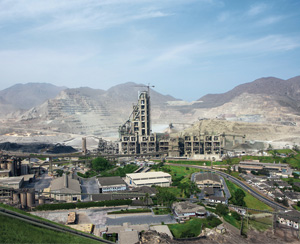South American cement markets have experienced diverse year-to-date trends, with lacklustre performances from Brazil and Colombia contrasting near-term prospects in Peru and a recovery in Argentina.
Brazil: pressures continue
Subdued economic activity and the uncertain political environment in Brazil have resulted in continued pressures for the domestic construction and cement markets. Earlier this week, data from SNIC, Brazil's national cement industry association, showed domestic cement sales in the first seven months of 2017 fell by 9.1 per cent YoY to 30.7Mt. In the 12 months ending July 2017 sales totalled 54.3Mt, down 9.8 per cent YoY. Including imports, consumption contracted by 9.7 per cent in the 12 months to the end of July 2017.
Paulo Camillo Penna, president of SNIC, said the recent figures are in line with expectations for the period. A better performance is expected in the coming months as traditionally the country sees higher consumption towards the end of the year. For 2017 SNIC anticipates that sales will fall by between 5-9 per cent. However, long-term prospects for the region's largest cement market remain positive, driven by the country’s continued housing shortage and the huge infrastructure gap to close.
Colombian challenges
In Colombia construction activity over the first half of 2017 has been negatively affected by a difficult economic environment and rains in several parts of the country. The National Administrative Department of Statistics (DANE) reported a 5.8 per cent drop in volumes for the industry in 2Q17.
In its second-quarter results, Colombia’s cement market leader Cementos Argos achieved a 6.9 per cent YoY increase in cement dispatches, which compares favourably with the overall industry performance, but revenues (-15.3 per cent) and EBITDA (-52.3 per cent) were dragged down by lower cement prices, which bottomed between April and May 2017. Going forward Argos is expecting flat volumes in the second half.
Cemex Latin American Holdings also saw a sharp first-half decline in Colombia, its biggest contributor, in terms of turnover (-14.3 per cent), EBITDA (-47.9 per cent), grey cement deliveries (-5 per cent) and the average cement price (-20 per cent in local currency terms). For the remainder of 2017, the company is expecting Colombia to show the weakest performance within its LatAm division with no volume improvement anticipated this year.
On a more positive note, Fitch Ratings stated in its new report on the Latin America cement sector that Colombia should benefit from announced 4G projects "which reached financing agreements and should be immune to the government's weakening fiscal situation and resulting pressure on commercial construction."
Peruvian prosepects
Peru's cement consumption is forecast to increase in 2017 following two years of decline. However, for the first seven months of 2017, domestic dispatches reached 4.618Mt, down 16 per cent YoY when compared with a volume of 5.499Mt in 7M16, according to the country’s cement association, Asocem. Domestic dispatches did edge up by 0.6 per cent YoY in July 2017 to 0.777Mt . Domestic supply was supplemented by 100t of imported cement and 44,400t of imported clinker.
Looking ahead, reconstruction works following El Niño damage, along with infrastructure investments totalling US$20-40bn set to be carried out before the end of 2018, are expected to boost cement consumption. Fitch highlighted Peru as one of the region's few bright spots and expects demand to accelerate going forward. The rating's agency writes: "Peruvian cement fundamentals remain strong on President Kuczynski's business-friendly and open-market policies. Preventing political opposition from derailing the administration's infrastructure push will be crucial."
Argentine recovery
Argentina, South America's second-largest economy, is emerging from its deep recession and is poised to see its strongest growth in six years in 2017, according to Morgan Stanley. Construction activity has increased, mainly helped by capital outlays, which represent 13 per cent of the 2017 government budget. Growing tourist numbers have led to a welcome uptick in hotel construction while the country is expanding its freight transport network as well as its tunnel links with neighbouring Chile.
Following a decline of 10.8 per cent last year, cement sales have largely been rising through 2017, with the exception of February. In the first seven months of this year demand advanced by 10.3 per cent YoY to 6.5Mt. Importers enjoyed a bountiful seven months as import volumes rocketed from 2944t in 7M16 to 36,858t one year later, according to cement industry association AFCP. Total cement dispatches rose 10.2 per cent from 5.9Mt in 7M16 to 6.5Mt in 7M17.
With economic forecasts positive, Argentina's construction activity is expected to increase by 1.6 per cent in 2017 and by 2.2 per cent in 2018. The ensuing benefits from the reactivation of public and private investment are likely to see cement consumption gradually increase over the 2017-18 period, reversing the loss recorded in 2016 and recovering some lost ground.


